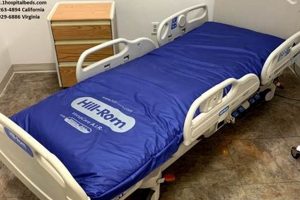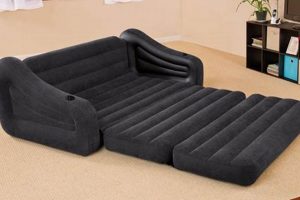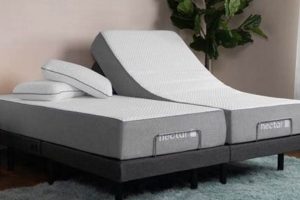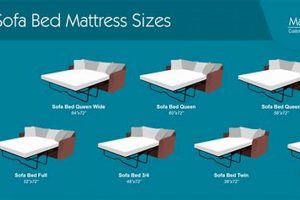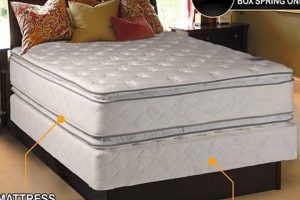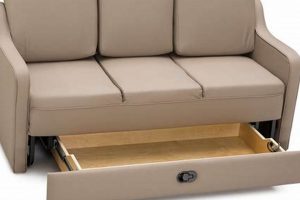The dimensions of a sleeping surface designed to fit within a pull-out or hideaway bed frame necessitate careful consideration. These under-bed units, often found in children’s rooms or guest rooms, are space-saving solutions requiring a mattress that adheres to specific height and length limitations. For example, a standard twin-size mattress, typically 39 inches wide and 75 inches long, is a common choice, though the thickness of the mattress is a critical factor.
Properly selecting the correct dimensions is paramount to ensure smooth operation of the trundle mechanism and prevent damage to both the bed frame and the mattress itself. Historically, these under-bed systems were conceived to maximize sleeping space in smaller living environments, offering flexibility without compromising valuable floor area. A well-chosen mattress maximizes comfort and extends the lifespan of the trundle unit.
Understanding the constraints of these bed frames is essential. This article will examine the typical dimensional requirements, discuss the impact of mattress thickness, and explore alternative mattress types suitable for trundle applications, providing a comprehensive guide to selecting the appropriate sleeping surface for these space-efficient beds.
Selecting the Appropriate Mattress Dimensions for Trundle Beds
Choosing the correct mattress dimensions is crucial for the optimal functioning and longevity of a trundle bed. These tips offer guidance to ensure a proper fit and comfortable sleeping experience.
Tip 1: Measure the Trundle Frame Interior: Obtain precise measurements of the interior space within the trundle frame before purchasing a mattress. These dimensions will dictate the maximum acceptable length, width, and, most importantly, height.
Tip 2: Prioritize Mattress Height: Mattress height is the most critical dimension. Exceeding the recommended height will impede the trundle’s ability to slide smoothly under the main bed frame. Typically, trundle mattresses should not exceed 8 inches in thickness. Some trundles require even thinner mattresses (5-6 inches) for proper clearance.
Tip 3: Consider the Main Bed Height: The height of the main bed frame affects the accessibility of the trundle unit. A lower main bed frame necessitates a thinner trundle mattress to ensure sufficient clearance for easy deployment.
Tip 4: Opt for Twin Size Primarily: Standard twin-size mattresses (approximately 39 inches wide and 75 inches long) are the most common configuration. However, confirm these dimensions align with the trundle frame’s specifications.
Tip 5: Explore Low-Profile Options: If height limitations are particularly stringent, consider low-profile mattresses designed specifically for trundle beds. These mattresses prioritize thinness while maintaining adequate support and comfort.
Tip 6: Account for Bedding: When calculating the maximum allowable mattress height, remember to factor in the space occupied by bedding, such as sheets and blankets. Overly thick bedding can further reduce clearance.
Tip 7: Verify Compatibility with the Manufacturer: Consult the trundle bed manufacturer’s specifications for recommended mattress dimensions. Adhering to these guidelines ensures compatibility and avoids potential warranty issues.
Selecting a mattress with appropriate dimensions ensures a seamless fit, prevents damage to the trundle mechanism, and provides a comfortable and supportive sleeping surface.
With a clearer understanding of mattress dimensions, the subsequent sections will explore mattress types and materials best suited for trundle applications.
1. Thickness limitations
Thickness limitations are a primary constraint in selecting a mattress for a trundle bed. The design of trundle units, which slide beneath a main bed frame, inherently restricts the vertical space available for the mattress. Failure to adhere to these limitations compromises the functionality of the trundle mechanism.
- Impeded Trundle Operation
Exceeding the maximum permissible thickness prevents the trundle from sliding smoothly under the main bed. The friction created by an oversized mattress can damage the trundle frame, the main bed, and the mattress itself. Forcefully attempting to close the trundle with an overly thick mattress may result in a jammed or inoperable mechanism.
- Compromised Main Bed Height
The overall height of the main bed is partially dictated by the required clearance for the trundle unit. A thicker trundle mattress necessitates a higher main bed frame, which may not be desirable or practical in certain room configurations. Conversely, a lower main bed frame necessitates an even thinner trundle mattress.
- Reduced Sleeper Comfort
While prioritizing thinness is essential, it’s crucial to balance this with sufficient comfort and support. Extremely thin mattresses often lack adequate cushioning, leading to discomfort and potential sleep disturbances. The selection process should aim for the thickest mattress possible within the stipulated height restrictions, maximizing comfort without sacrificing functionality.
- Material Constraints
The thickness limitations also impact the types of materials that can be used in the mattress construction. For example, thick innerspring or hybrid mattresses may be unsuitable due to their overall height. Instead, thinner alternatives like foam or latex mattresses are often preferred for trundle applications.
Therefore, understanding and respecting thickness limitations is paramount. The selection process should begin with a precise measurement of the available space within the trundle frame, followed by a careful assessment of various mattresses that fall within those dimensional parameters. The objective is to find a mattress that offers optimal comfort and support while ensuring the smooth and unobstructed operation of the trundle bed.
2. Twin size (standard)
The term “Twin size (standard)” directly relates to “what size mattress for trundle bed” as it is the most frequently compatible mattress dimension for these under-bed units. The standard twin mattress, typically measuring 39 inches wide by 75 inches long, is often designed to fit within the confines of a trundle frame. This is a design consideration that ensures both space efficiency and usability. The prevalence of twin-size mattresses in trundle beds stems from their compact footprint, allowing the trundle unit to easily slide under a twin, full, queen, or even king-sized primary bed. Failing to adhere to the standard twin size may result in the trundle mattress not fitting within the designated space, rendering the trundle bed unusable.
For example
, manufacturers designing trundle beds commonly assume the use of a standard twin mattress. Therefore, the internal dimensions of the trundle frame are deliberately crafted to accommodate these specific measurements. Any deviation from this standard, such as attempting to use a twin XL or a full-size mattress, typically proves incompatible. This is further complicated by height restrictions, a crucial aspect discussed in the previous section. The thickness of a standard twin mattress must also fall within the trundle’s allowable height, which often necessitates selecting thinner, low-profile twin mattresses.
In conclusion, the standard twin size is a critical component when considering mattress dimensions for trundle beds. While variations and exceptions exist, the adherence to these dimensions ensures both functionality and space optimization. Ignoring the necessity of a standard twin or a compatible alternative will likely negate the benefits of a trundle bed, resulting in an unusable or ill-fitting mattress. The next steps will be to elaborate other key considerations that will help you to choose a perfect mattress.
3. Frame interior measurements
Frame interior measurements are directly causative to determining the appropriate mattress dimensions for trundle beds. The internal dimensions of the trundle frame dictate the maximum permissible length, width, and height of the mattress. Inaccurate measurements or a failure to account for these dimensions result in a mattress that either does not fit within the frame or impedes its functionality. This correlation necessitates precise measurements prior to mattress selection.
The practical significance of understanding this relationship is multifaceted. For instance, a trundle frame with internal dimensions of 38 inches wide and 74 inches long requires a mattress that is smaller than or equal to those measurements. Attempting to fit a standard twin mattress (39 x 75 inches) into this frame would prove unsuccessful. This also directly affects the height; some frames are designed to fit a mattress no more than 6 inches thick. An 8-inch mattress, commonly found with memory foam designs, would not allow the frame to slide properly under the main bed. In these scenarios, understanding the interior measurements prevents costly mistakes and ensures the trundle bed functions as intended.
In summary, accurate frame interior measurements form the foundation for selecting the correct mattress size for trundle beds. These measurements, when correctly applied, guarantee compatibility and prevent operational issues. The practical implications extend to cost savings, preventing damage to the trundle mechanism, and ensuring the longevity of both the frame and the mattress. This understanding is paramount for anyone seeking to optimize the functionality and utility of a trundle bed system.
4. Low-profile options
Low-profile mattress options are inextricably linked to determining the appropriate size for a trundle bed. These specialized mattresses address the crucial dimensional constraints inherent in trundle bed designs. Trundle beds, by nature, require a mattress of reduced height to allow the under-bed unit to slide smoothly beneath the main bed frame. Consequently, low-profile mattresses represent a targeted solution to this unique spatial challenge, making their consideration essential when addressing “what size mattress for trundle bed.”
The selection of low-profile mattress options directly affects the functionality and usability of a trundle bed. If a standard-height mattress were employed, the trundle unit would be unable to retract completely, rendering the bed unusable. For example, a standard innerspring mattress, often exceeding 10 inches in thickness, is incompatible with most trundle frames. Low-profile alternatives, typically ranging from 4 to 8 inches in height, are specifically engineered to circumvent this issue, permitting the trundle bed to operate as intended. These options often incorporate materials such as memory foam or latex to provide adequate support within the reduced thickness.
In summary, low-profile mattress options are a critical component when considering “what size mattress for trundle bed.” Their reduced height ensures compatibility with the spatial constraints of trundle frames, enabling the smooth operation of the unit. While the selection of a low-profile mattress may necessitate compromises in terms of thickness or material composition, it is a necessary adaptation to optimize the functionality of a trundle bed system. Understanding the importance of these options allows for informed decision-making and ensures that the chosen mattress meets the unique requirements of this space-saving sleep solution.
5. Weight capacity
Weight capacity represents a critical, yet often overlooked, parameter when considering mattress dimensions for trundle beds. The structural integrity of the trundle frame and its support system dictates the maximum weight it can safely accommodate. Exceeding this limit poses risks to the frame’s structural integrity and the sleeper’s safety.
- Frame Integrity and Material Stress
The trundle frame, typically constructed from wood or metal, is engineered to withstand a specific load. Excessive weight concentration beyond this designed limit can cause warping, bending, or even fracture of the frame components. Such structural failure compromises the trundle’s ability to function smoothly and presents a potential safety hazard. For example, a wooden trundle frame designed for a maximum weight of 200 pounds may suffer damage if subjected to 300 pounds regularly.
- Mattress Support and Longevity
The support system within the trundle bed, often consisting of slats or a metal grid, is also subject to weight limitations. Overloading this support structure leads to uneven weight distribution across the mattress, causing premature sagging and reduced lifespan. A mattress placed on an overloaded trundle base will degrade much faster than one on a properly supported surface, regardless of its intrinsic quality.
- Operational Functionality and Glide Mechanism
Excessive weight can hinder the smooth operation of the trundle’s glide mechanism. The added friction from an overloaded mattress increases the effort required to extend and retract the trundle unit. This can lead to strain on the wheels or sliders, causing premature wear and tear or even complete failure of the mechanism. A trundle designed to easily slide may become difficult or impossible to move under excessive weight.
- Safety Considerations and Potential Hazards
The most significant implication of exceeding the weight capacity is the potential for safety hazards. A collapsing trundle frame or a failing support system can result in injury to the sleeper. Furthermore, unstable or compromised components can create pinch points or sharp edges, posing additional risks. Prioritizing adherence to weight limits is paramount to ensuring a safe sleeping environment.
Therefore, understanding and respecting the weight capacity of a trundle bed is crucial when selecting a mattress
. A lightweight, low-profile mattress, while often preferred for dimensional reasons, must also be assessed for its ability to support the intended user. Matching the mattress dimensions with weight considerations ensures both the functionality and safety of the trundle bed system.
6. Bedding clearance
Bedding clearance, a crucial consideration directly influencing “what size mattress for trundle bed,” refers to the available vertical space within the trundle unit after the mattress is in place and before the unit is slid beneath the main bed. Insufficient clearance can impede the trundle’s operation and negatively impact the longevity of both the bedding and the trundle mechanism.
- Compression and Damage to Bedding
Inadequate bedding clearance results in the compression of sheets, blankets, and comforters when the trundle is retracted. This constant compression can accelerate wear and tear on the bedding materials, leading to premature degradation and a reduced lifespan. Thick comforters or multiple layers of bedding are particularly susceptible to this issue. For example, a trundle unit with only 2 inches of bedding clearance will quickly damage a 4-inch thick comforter.
- Impeded Trundle Operation and Increased Friction
Excess bedding encroaching on the limited space within the trundle compartment creates friction between the bedding, the mattress, and the trundle frame. This increased friction makes it more difficult to slide the trundle unit in and out, potentially damaging the glide mechanism over time. The added resistance may also require more force to operate the trundle, increasing the risk of accidental injury or damage to the surrounding furniture.
- Airflow Restriction and Potential for Moisture Buildup
Limited bedding clearance restricts airflow around the mattress and bedding. This can lead to moisture buildup, creating a favorable environment for mold, mildew, and dust mites. Such conditions not only compromise the hygiene of the sleeping environment but can also exacerbate allergies and respiratory issues. The restricted airflow prevents the bedding from adequately drying after use, increasing the risk of these issues.
- Aesthetic Considerations and Reduced Functionality
Visually, an overstuffed trundle unit detracts from the overall aesthetic appeal of the bed. More importantly, it reduces the trundle’s intended functionality. An inability to easily access the trundle bed due to excessive bedding discourages its use, negating the benefits of this space-saving sleeping solution. The convenience of having an extra bed readily available is compromised when deploying or retracting the trundle becomes a laborious task.
These facets highlight the importance of assessing bedding clearance when determining “what size mattress for trundle bed.” Selecting a thinner mattress may be necessary to ensure adequate space for bedding, mitigating the risks of damage, operational difficulties, and hygiene concerns. This holistic approach ensures that the trundle bed remains a functional, aesthetically pleasing, and healthy sleeping solution.
7. Manufacturer specifications
Adherence to manufacturer specifications is paramount when determining the appropriate mattress dimensions for trundle beds. These guidelines, provided by the bed’s producer, outline the precise dimensional parameters required for safe and effective operation of the trundle mechanism. Ignoring these specifications can lead to functional issues, safety hazards, and voided warranties.
- Dimensional Tolerances and Compatibility
Manufacturers design trundle beds with specific dimensional tolerances to ensure compatibility with mattresses. Deviating from these dimensions, even by a fraction of an inch, can prevent the trundle from sliding smoothly or fitting properly beneath the main bed frame. For example, a manufacturer might specify a maximum mattress thickness of 8 inches and a length of 75 inches. Using a mattress exceeding these limits would impede the trundle’s operation. Adhering to these figures guarantees that the mattress will fit within the designated space and allow the trundle mechanism to function as intended.
- Weight Capacity Limitations and Safety Ratings
Manufacturer specifications also include weight capacity limitations, indicating the maximum weight the trundle frame and support system can safely bear. Exceeding these limits can compromise the structural integrity of the trundle, potentially leading to collapse or injury. For instance, a trundle bed may be rated for a maximum weight of 200 pounds. Using a mattress and sleeper exceeding this weight could damage the frame. Following the recommended weight limits is essential for ensuring the safety and longevity of the trundle bed.
- Warranty Compliance and Potential Voidance
Failure to adhere to manufacturer specifications often voids the warranty on the trundle bed. Warranties typically stipulate that the trundle be used in accordance with the provided guidelines, including mattress size and weight limitations. Using an incompatible mattress could be interpreted as misuse, resulting in denial of warranty claims in the event of damage or malfunction. Carefully reviewing and adhering to the manufacturer’s recommendations is necessary to maintain warranty coverage.
- Material Recommendations and Performance Optimization
Some manufacturers provide recommendations regarding mattress materials to optimize performance and longevity. These recommendations may consider factors such as mattress weight, flexibility, and breathability in relation to the trundle design. For instance, a manufacturer might suggest using a foam mattress rather than an innerspring mattress due to its lighter weight and better conformability within the trundle compartment. Heeding these recommendations can enhance the comfort, durability, and overall functionality of the trundle bed system.
Ultimately, consulting and adhering to manufacturer specifications is critical when selecting a mattress for a trundle bed. These guidelines encompass dimensional tolerances, weight capacity limits, warranty considerations, and material recommendations, all of which contribute to the safe and effective operation of the trundle system. Ignoring these specifications can have detrimental consequences, compromising functionality, safety, and warranty coverage. Prioritizing compliance with manufacturer guidelines ensures that the chosen mattress is compatible with the trundle bed, maximizing its benefits as a space-saving sleeping solution.
Frequently Asked Questions
The following questions address common concerns and misconceptions regarding mattress sizes for trundle beds. Precise dimensions are essential for proper functionality and safety.
Question 1: What is the standard mattress size typically used in trundle beds?
The standard mattress size commonly used in trundle beds is a twin, measuring approximately 39 inches wide and 75 inches long. However, precise measurements of the trundle frame’s interior are crucial to confirm compatibility.
Question 2: What is the maximum recommended thickness for a trundle bed mattress?
The maximum recommended thickness for a trundl
e bed mattress typically ranges from 5 to 8 inches. This dimension is critical to ensure that the trundle unit can slide smoothly under the main bed frame. Exceeding this thickness may impede functionality.
Question 3: Can a full-size mattress be used in a trundle bed?
Generally, a full-size mattress cannot be used in a standard trundle bed. Trundle beds are primarily designed to accommodate twin-size mattresses. Attempting to use a larger mattress will prevent the trundle from operating correctly.
Question 4: How do I determine the correct mattress size for my specific trundle bed?
The correct mattress size is determined by measuring the interior dimensions of the trundle frame. These measurements, specifically the length, width, and maximum allowable thickness, dictate the appropriate mattress dimensions.
Question 5: Does the weight capacity of a trundle bed affect the choice of mattress?
Yes, the weight capacity of the trundle bed directly impacts the choice of mattress. The combined weight of the mattress and the sleeper must not exceed the trundle frame’s stated weight limit to prevent structural damage or safety hazards.
Question 6: Where can I find the manufacturer’s specifications for my trundle bed’s mattress size requirements?
Manufacturer specifications are typically found in the trundle bed’s assembly instructions, owner’s manual, or on the manufacturer’s website. Consulting these resources is crucial to ensure compatibility and avoid voiding the warranty.
Accurate mattress dimensions are vital for trundle bed functionality and user safety. Always measure the trundle frame and adhere to manufacturer specifications.
The subsequent section will explore the various types of mattresses suitable for trundle beds, taking into account dimensional constraints and comfort considerations.
Determining the Correct Mattress Dimensions for Trundle Beds
The exploration of the phrase “what size mattress for trundle bed” reveals the critical importance of dimensional accuracy. Success hinges on precise frame interior measurements, adherence to manufacturer specifications, and consideration of weight capacity limitations. The selection process must prioritize height restrictions to ensure proper trundle operation, often necessitating low-profile mattress options. Failure to address these factors risks compromising functionality, safety, and the lifespan of both the mattress and the trundle unit itself.
Therefore, selecting a mattress transcends simple preference. It requires a thorough assessment of the trundle bed’s individual requirements and a commitment to informed decision-making. Investing the time to verify dimensions and weight ratings ensures a functional and safe sleeping environment, maximizing the utility of this space-saving solution.


